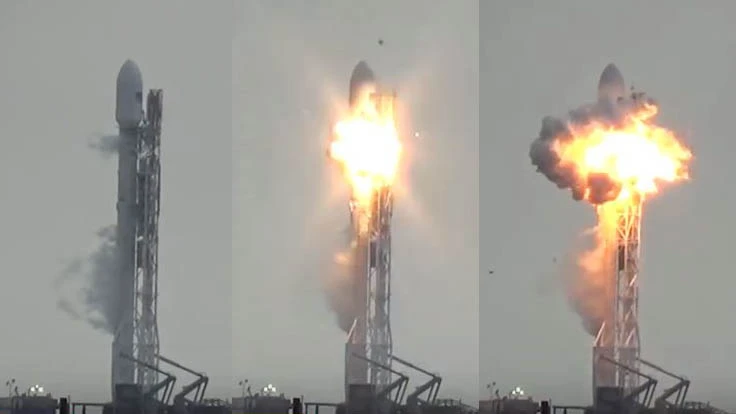
Cape Canaveral Florida – A SpaceX two-stage Falcon 9 rocket and its AMOS-6 communications satellite payload were destroyed during a pre-launch static fire test at SpaceX’s Cape Canaveral Space Launch Complex 40 at approximately 9:07 am EDT, Sept. 1, 2016. The spacecraft’s launch was scheduled for Sept. 3, 2016.
According to a SpaceX press release, “The anomaly originated around the upper stage oxygen tank and occurred during propellant loading of the vehicle. All personnel were clear of the pad and there were no injuries.”
SpaceX officials are continuing to review the data to identify the root cause.
The first stage of the 70m (229ft) tall Falcon 9 is powered by nine SpaceX-developed Merlin rocket engines; the second stage – where the explosion appeared to originate – has a single Merlin Vacuum engine to boost payloads into orbit. Both stages use rocket-grade (RP-1) kerosene and liquid oxygen as propellant.
There may be a clue to the cause of the explosion. On June 28, 2015, following a nominal liftoff, a SpaceX Falcon 9 experienced an overpressure event in the upper-stage liquid oxygen tank approximately 139 seconds into flight, resulting in loss of the vehicle and payload, an unmanned commercial resupply (CRS) cargo mission to the International Space Station.
The Israel Aerospace Industries AMOS-6 satellite reportedly cost $85 million and was built for satellite services company Spacecom to relay Internet broadband in Africa and television to Europe and the Middle East.
The 5.4-ton AMOS-6 featured an electric propulsion subsystem and a 10kW electric power subsystem.
Dramatic video of the Sept. 1 mishap was captured by USLaunchReport.com, a U.S. disabled-veteran run, non-profit video production company. The anomaly occurs at the 1:11 mark.
Multiple sources – see links
According to a SpaceX press release, “The anomaly originated around the upper stage oxygen tank and occurred during propellant loading of the vehicle. All personnel were clear of the pad and there were no injuries.”
SpaceX officials are continuing to review the data to identify the root cause.
The first stage of the 70m (229ft) tall Falcon 9 is powered by nine SpaceX-developed Merlin rocket engines; the second stage – where the explosion appeared to originate – has a single Merlin Vacuum engine to boost payloads into orbit. Both stages use rocket-grade (RP-1) kerosene and liquid oxygen as propellant.
There may be a clue to the cause of the explosion. On June 28, 2015, following a nominal liftoff, a SpaceX Falcon 9 experienced an overpressure event in the upper-stage liquid oxygen tank approximately 139 seconds into flight, resulting in loss of the vehicle and payload, an unmanned commercial resupply (CRS) cargo mission to the International Space Station.
The Israel Aerospace Industries AMOS-6 satellite reportedly cost $85 million and was built for satellite services company Spacecom to relay Internet broadband in Africa and television to Europe and the Middle East.
The 5.4-ton AMOS-6 featured an electric propulsion subsystem and a 10kW electric power subsystem.
Dramatic video of the Sept. 1 mishap was captured by USLaunchReport.com, a U.S. disabled-veteran run, non-profit video production company. The anomaly occurs at the 1:11 mark.
Multiple sources – see links
Latest from Aerospace Manufacturing and Design
- Happy New Year
- 2024 Favorites: #1 Article –2024 Forecast
- 2024 Favorites: #1 News – Honeywell to expand Kansas aerospace manufacturing facility
- 2024 Favorites: #2 Article – Hill helicopters get ready for lift-off
- 2024 Favorites: #2 News – GE Aerospace to develop next phase of advanced engine
- 2024 Favorites: #3 Article – Generative design in aerospace
- 2024 Favorites: #3 News – Hadley engine flies for the first time
- 2024 Favorites: #4 Article – Data challenges affect nearly all manufacturers





